Pembrokeshire Coast
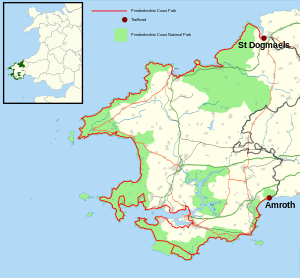
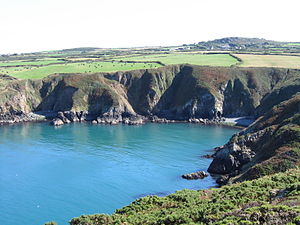
The Pembrokeshire Coast stretches from the River Nefern in the north, round the county to the beach at Amroth in the south, encompassing stunning natural scenery of clifs, beaches, meadow and moor and scattered islands offshore. The coast is followed by the Pembrokeshire Coast Path and the coast, littoral and islands are designated a national park: the Pembrokeshire Coast National Park.
National Park
The Pembrokeshire Coast National Park was established in 1952, and it is the only one in the United Kingdom to have been designated primarily because of its spectacular coastline.
This is one of fourteen National Parks in the United Kingdom. All of the others cover ranges of hills or, in one case, forest land.
The National Park has a varied landscape of rugged cliffs, sandy beaches, wooded estuaries and wild inland hills, covering a total area of 243 square miles. It falls into four distinct sections. Running clockwise around the coast, these are the south Pembrokeshire coast, including Caldey Island; the Daugleddau estuary; the St Bride's Bay coast, including the coastal islands; and the Preseli Hills. However, not all of the park is coastal, and there are even forests and marshes on the edges of the park.
Not all of the park is coastal; there are forests and marshes on the edges of the park.
Landscape
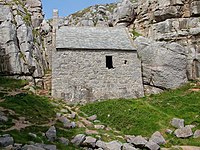
The geology of the Pembrokeshire coast is of particular interest with many good exposures both inland and along the coast, exhibiting a variety of rock types and structural features such as natural arches, sea stacks, rock folding and sea caves. A stack of note is Stack Rocks (Elegug Stacks), two large detached pillars of limestone.[1] In the north, the rocks of Carn Llidi, Pen Beri and Garn Fawr, together with the extensive moorland inland on Carningli and Preseli (within the National Park), give an exposed and mountainous feel to the landscape, cut through by the wooded valleys of the Gwaun and Nevern.
In the west, the coastland is dominated by the broad sweep of St Bride's Bay, bounded by headlands reaching towards two islands: at its northern end Ramsey Island, near St David's peninsula, and at its southern end Skomer.
The southern coast is another contrast, with the limestone plateau and cliffs of the Castlemartin peninsula, the steep-sided wooded valleys inland from Amroth; the Bosherston lakes - now, like much of the coastal strip, in the care of the National Trust - and the tourist resorts of Tenby and Saundersfoot. Between the western and southern areas of the National Park lies the Milford Haven waterway, where the tranquil Daugleddau estuary feeds into one of the finest natural deep water harbours in the world.[2]
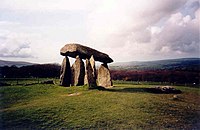
The National Park includes many sites, such as the cromlech Pentre Ifan, and areas which are of national or international conservation significance in their own right, including seven Special Areas of Conservation, a Marine Nature Reserve, six national nature reserves and seventy-five Sites of Special Scientific Interest.
In 2011, National Geographic magazine voted Pembrokeshire the second best coastal destination in the world.[3][4]
Pembrokeshire Coast Path
- Main article: Pembrokeshire Coast Path
The Pembrokeshire Coast Path is a designated National Trail.[5] It was established in 1970, and is 186 miles long, mostly at cliff-top level, with a total of 35,000 feet of ascent and descent.
The southern end of the path is at Amroth. The northern end is often regarded as being at Poppit Sands, near St Dogmaels, where the official plaque was originally sited[6] but the path now continues to St. Dogmaels,[7][8] where a new marker was unveiled in July 2009.[9]
The Pembrokeshire Coast Path forms part of the Wales Coast Path, an 870-mile long-distance walking route around the whole coast of Wales from Chepstow to Queensferry, which was officially opened in 2012.[10]
Administration
The Park is managed by Pembrokeshire Coast National Park Authority, whose purposes are to conserve the National Park, encourage the public to enjoy and understand it, and to foster the social and economic well-being of the communities within its boundaries. Its offices are in Pembroke Dock.[11]
The Authority also manages the entire length of the Pembrokeshire Coast Path.
Beaches
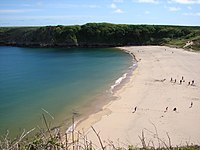
Beaches in the park include:
- Abereiddy
- Amroth
- Barafundle Bay
- Broad Haven
- Broad Haven South
- Freshwater East
- Freshwater West
- Manorbier
- Marloes
- Newgale
- Newport
- Poppit Sands
- Sandy Haven
- Saundersfoot
- Tenby
- Whitesands Bay
Outside links
References
- ↑ "Stack Rocks/St Govan's". BBC Wales. http://www.bbc.co.uk/wales/southwest/nature/thingstodo/walks/allwalks/stack_rocks_st_govans.shtml. Retrieved 5 February 2011.
- ↑ http://www.pcnpa.org.uk/PCNP/live/sitefiles/related_items/NPMP.pdf
- ↑ www.NationalTrails.co.uk - news article
- ↑ www.WalesOnline.co.uk - Accolade of being one of world's top trails
- ↑ "Pembrokeshire Coast Path". National Trails. http://www.nationaltrail.co.uk/trail.asp?PageId=33. Retrieved 14 August 2013.
- ↑ "Coast Path Marker". Pembrokeshire Coastal Photography. http://www.pemcoastphotos.com/photo_7626422.html. Retrieved 29 May 2014.
- ↑ John, Brian (2012). Pembrokeshire Coast Path. Aurum Press. ISBN 978-1845137823.
- ↑ "Pembrokeshire Coast Path: Newport to St Dogmaels". visitpembrokeshire.com. http://www.visitpembrokeshire.com/content.asp?nav=9,25&parent_directory_id=1. Retrieved 14 August 2013.
- ↑ "St Dogmaels to Newport (Town) 16 miles". Planning a Trip. National Trails. http://nt.pcnpa.org.uk/website/sitefiles/nat_trail.asp. Retrieved 14 August 2013.
- ↑ "All-Wales coast path nears completion". BBC News Wales. 17 October 2011. http://www.bbc.co.uk/news/uk-wales-15283462. Retrieved 14 August 2013.
- ↑ Pembrokeshire Coast National Park Authority
| National Parks of the United Kingdom |
|---|
|
Brecon Beacons • Cairngorms • Dartmoor • Exmoor • Lake District • Loch Lomond and the Trossachs • New Forest • North York Moors • Northumberland • Peak District • Pembrokeshire Coast • Snowdonia • South Downs • Yorkshire Dales |